Holly Thompson's Blog, page 41
October 3, 2010
Kamakura Yabusame
Yesterday yabusame (mounted archery) was held at the Tsurugaoka Hachiman Shrine, in Kamakura. The event has its origins in the Kamakura period (1185-1333) and draws huge crowds. I'd been before and seen little other than a horse and rider speeding past in a blur, the view of the targets and track completely blocked by other spectators. This time I ended up where horses and archers assembled just before the event began, then was able to move forward for a view of the track.
In the event, archers careen down a narrow track on horseback while attempting to draw an arrow, shoot and hit a wooden target while speeding past. There are three targets. At least one of the riders hit all three yesterday.
The event is ritualized with processions and Shinto ceremony beforehand. The wood targets are part of the procession...

Before the start...

A mounted archer before approaching the track...

Archers ride in rounds of three and are first led down the length of track...
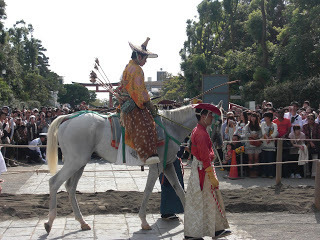
The official start to yabusame is proclaimed...

Galloping down the track...
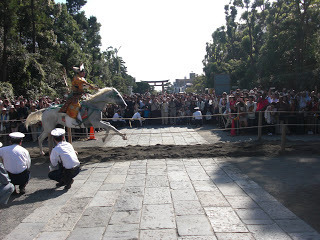 drawing an arrow for the final target...
drawing an arrow for the final target...
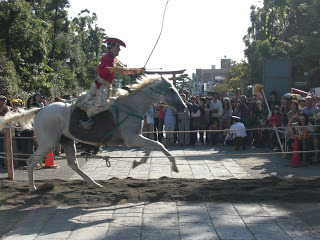 All in all, not bad for Sunday afternoon entertainment.
All in all, not bad for Sunday afternoon entertainment.
In the event, archers careen down a narrow track on horseback while attempting to draw an arrow, shoot and hit a wooden target while speeding past. There are three targets. At least one of the riders hit all three yesterday.
The event is ritualized with processions and Shinto ceremony beforehand. The wood targets are part of the procession...

Before the start...

A mounted archer before approaching the track...

Archers ride in rounds of three and are first led down the length of track...

The official start to yabusame is proclaimed...

Galloping down the track...
 drawing an arrow for the final target...
drawing an arrow for the final target... All in all, not bad for Sunday afternoon entertainment.
All in all, not bad for Sunday afternoon entertainment.
Published on October 03, 2010 17:19
September 23, 2010
Tsukimi
Tsukimi (月見) or moon viewing is celebrated in Japan on the eighth month of the lunar calendar, which, this year fell on September 22. Although rain was predicted, the skies remained clear, and the rising harvest moon was brilliant. Traditionally various autumn vegetables and fruits are set out as offerings of gratitude along with susuki grass and pyramids of mochi dango. When we lived in a house that had a garden patch of susuki we would set up the foods by a window where the moonlight shone in.
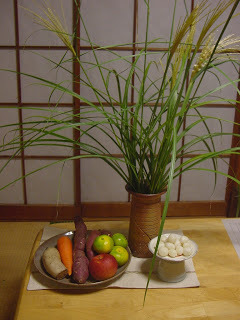
Round foods are often on our dinner menu on tsukimi nights:
rounds of carrots and shiitake beside a tsukimi burger
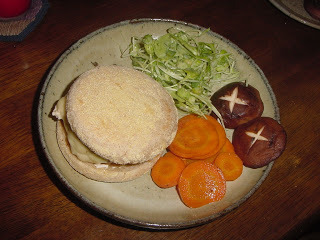
dango with azuki and and montblanc with chestnut
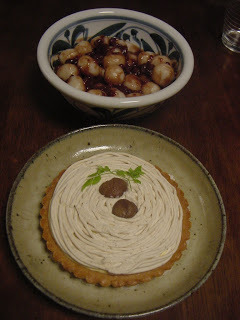
and this week's tsukimi menu--skewers of tsukune (chicken meatballs), round tofu, sweet potato rounds in rice, zucchini rounds, , and, okay, salad in a round dish.
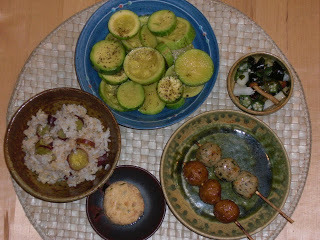
This year we were able to eat our tsukimi meal outside by candle- and moonlight. Perfect.

Round foods are often on our dinner menu on tsukimi nights:
rounds of carrots and shiitake beside a tsukimi burger

dango with azuki and and montblanc with chestnut

and this week's tsukimi menu--skewers of tsukune (chicken meatballs), round tofu, sweet potato rounds in rice, zucchini rounds, , and, okay, salad in a round dish.

This year we were able to eat our tsukimi meal outside by candle- and moonlight. Perfect.
Published on September 23, 2010 19:24
September 21, 2010
Otaru Kombu
Anywhere I travel I seek out areas with preserved old buildings. This week I took a brief trip to Hokkaido. Most of my time was spent in urban Sapporo, but I managed to get out of the city for some hiking near Lake Shikotsu and for a brief visit to Otaru, a fishing port on Ishikari Bay northwest of Sapporo.
My main reason for going to Otaru was to see the preserved warehouses and shops dating from the late nineteenth and early twentieth centuries and the partially preserved canal.

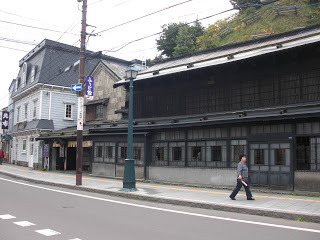

Given my interest in seaweeds, my favorite shop was, of course, the Kombu Kan, specializing in kombu kelp (Laminaria angustata).
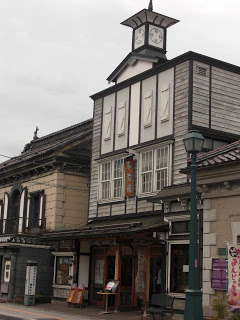
Long fronds of kelp were draped from the ceiling.
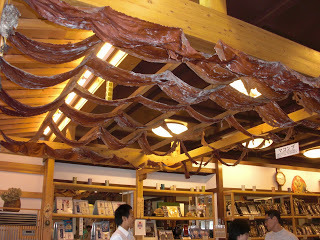
I came home with kombu snacks and kombu tea--the salty fragrance of which takes you straight to the sea. Maybe next trip to Hokkaido I can visit the kombu harvesting towns...
My main reason for going to Otaru was to see the preserved warehouses and shops dating from the late nineteenth and early twentieth centuries and the partially preserved canal.



Given my interest in seaweeds, my favorite shop was, of course, the Kombu Kan, specializing in kombu kelp (Laminaria angustata).

Long fronds of kelp were draped from the ceiling.

I came home with kombu snacks and kombu tea--the salty fragrance of which takes you straight to the sea. Maybe next trip to Hokkaido I can visit the kombu harvesting towns...
Published on September 21, 2010 19:49
September 11, 2010
Learning from Jane Goodall
Yesterday I had the good fortune to hear the celebrated chimpanzee authority Jane Goodall speak at a school in Yokohama. Some 600 people--elementary, middle and high schools students plus teachers and parents--crowded into the school gym. Outside the temperature was about 30 degrees C, and the temperature inside the packed, unairconditioned gym rose uncomfortably as we waited for Jane Goodall to step up to the podium; we flapped fans, mopped our faces with handkerchiefs, and I wondered how on earth she would hold our collective attention for an hour in the heat without any slide show or visuals.
But from the moment she began her talk with her chimpanzee greeting to the audience until the final question from a young student--about Dr. Goodall's influential and ever supportive mother--we were all riveted.
 Midway through the talk she reminded us as we wilted in our chairs that gathering without air conditioning was a good thing for the earth.
Midway through the talk she reminded us as we wilted in our chairs that gathering without air conditioning was a good thing for the earth.
Afterward kids, parents and teachers alike spoke enthusiastically, clearly motivated to make the world a better place for people, animals and nature...individually or through the Roots and Shoots program.

It reassured me to hear the enthusiasm from all the students, and it reassured me to see that an engaging talk on the environment without a powerpoint or video backup, even in a hot school gym, could hold the attention of the young and old in this age of high-tech distractions.
But from the moment she began her talk with her chimpanzee greeting to the audience until the final question from a young student--about Dr. Goodall's influential and ever supportive mother--we were all riveted.
 Midway through the talk she reminded us as we wilted in our chairs that gathering without air conditioning was a good thing for the earth.
Midway through the talk she reminded us as we wilted in our chairs that gathering without air conditioning was a good thing for the earth.Afterward kids, parents and teachers alike spoke enthusiastically, clearly motivated to make the world a better place for people, animals and nature...individually or through the Roots and Shoots program.

It reassured me to hear the enthusiasm from all the students, and it reassured me to see that an engaging talk on the environment without a powerpoint or video backup, even in a hot school gym, could hold the attention of the young and old in this age of high-tech distractions.
Published on September 11, 2010 02:09
September 7, 2010
Crane Beach
Typhoon #9 is pouring down on us here in Kanagawa, but before summer disappears completely I want to share photos of a place I try to visit every time I go back to Massachusetts--Crane Beach, or to locals, Crane's. It is a landscape etched in my earliest memories. When I was 19 and a budding biologist, I worked as a tern warden at the beach and completed a study of Least Terns that nest precariously in hollows of sand between the dunes and the surf. I would survey the nests, count eggs, post signs, set up fencing to keep people out, and make observations of the tern colonies. It was a solitary job, but what a great place to have to walk several miles each day with the ever shifting light, the rolling dunes, and vast sandbars exposed as the tide receded.
A few shots from visits this August:

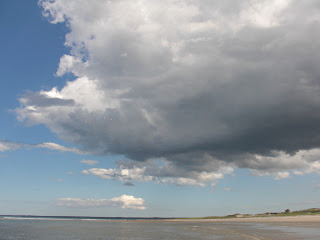

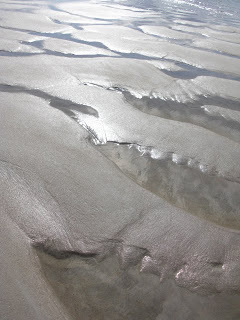
Crane Beach lies within the Great Marsh, an enormous salt marsh that extends from Cape Ann on the Massachusetts North Shore all the way to New Hampshire. Much of the area is preserved. As I flew out of Boston to return to Japan this summer, instead of going west right away, the plane flew east to just inland of the marsh then north. From my window seat I could see the broad stretch of green, islands and waterways, and the white swaths of beaches--an unexpected farewell gift.
A few shots from visits this August:




Crane Beach lies within the Great Marsh, an enormous salt marsh that extends from Cape Ann on the Massachusetts North Shore all the way to New Hampshire. Much of the area is preserved. As I flew out of Boston to return to Japan this summer, instead of going west right away, the plane flew east to just inland of the marsh then north. From my window seat I could see the broad stretch of green, islands and waterways, and the white swaths of beaches--an unexpected farewell gift.
Published on September 07, 2010 23:29
August 30, 2010
Angkor Dance Troupe
Book research leads to amazing discoveries sometimes. This summer my research led me to the Angkor Dance Troupe based in Lowell, Massachusetts, a city not far from where I grew up and with a population estimated to be between 10 and 20 percent Cambodian. I was able to meet with Tim Thou, founder and program director, and with senior and junior dance instructors--all in their teens and early twenties.
Proeung Chhieng, Vice Rector and Dean of Choreographic Arts at the Royal School of Fine Arts in Phnom Penh, was visiting and working with the troupe while I was there. I was fortunate to have the chance to watch rehearsals of several dances.

Later at the Southeast Asian Water Festival on August 21, I watched the resulting performances:
the Good Crops folk dance,
 a classical piece,
a classical piece,
 and a contemporary piece.
and a contemporary piece.
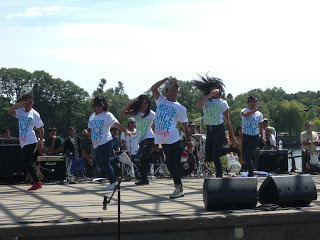
Check out this video on the Angkor Dance Troupe website. And if you'll be in Massachusetts in August next year, don't miss the Lowell Southeast Asian Water Festival.
Proeung Chhieng, Vice Rector and Dean of Choreographic Arts at the Royal School of Fine Arts in Phnom Penh, was visiting and working with the troupe while I was there. I was fortunate to have the chance to watch rehearsals of several dances.

Later at the Southeast Asian Water Festival on August 21, I watched the resulting performances:
the Good Crops folk dance,
 a classical piece,
a classical piece, and a contemporary piece.
and a contemporary piece. 
Check out this video on the Angkor Dance Troupe website. And if you'll be in Massachusetts in August next year, don't miss the Lowell Southeast Asian Water Festival.
Published on August 30, 2010 22:15
July 19, 2010
Shonan Returning
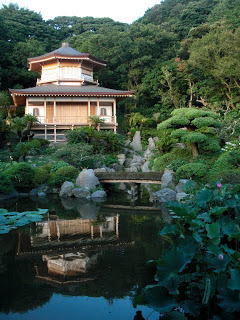 Not long ago I left the urban life of Yokohama and moved back to the Shonan coast of Kanagawa. How lucky I feel to be back in an area rich in history, full of back lanes great for cycling, with hills as backdrop, by the sea. In Yokohama I found myself not knowing what season it was. The area we lived in had few temples or shrines and few festivals marking important times of the year. Homes were mostly new with small or nonexistent gardens without the traditional plantings that in Japan so clearly mark the seasons.
Not long ago I left the urban life of Yokohama and moved back to the Shonan coast of Kanagawa. How lucky I feel to be back in an area rich in history, full of back lanes great for cycling, with hills as backdrop, by the sea. In Yokohama I found myself not knowing what season it was. The area we lived in had few temples or shrines and few festivals marking important times of the year. Homes were mostly new with small or nonexistent gardens without the traditional plantings that in Japan so clearly mark the seasons. We moved to our new neighborhood here in time for the local shrine's summer festival that dates back hundreds of years, a festival to pray for good health in the coming year. On the last night of the festival we joined neighbors dancing bon dances around a huge tree. The mikoshi portable shrine was carried on the shoulders of neighborhood men round and round the tree before being put away until the next festival. Last week the cicadas started singing in the woods behind the shrine. Yesterday we saw a kingfisher among the lotus blooms in a nearby temple pond then cycled to the beach and watch hula dancers. This week are the summer fireworks. There is no doubt what season it is.
Published on July 19, 2010 06:42



